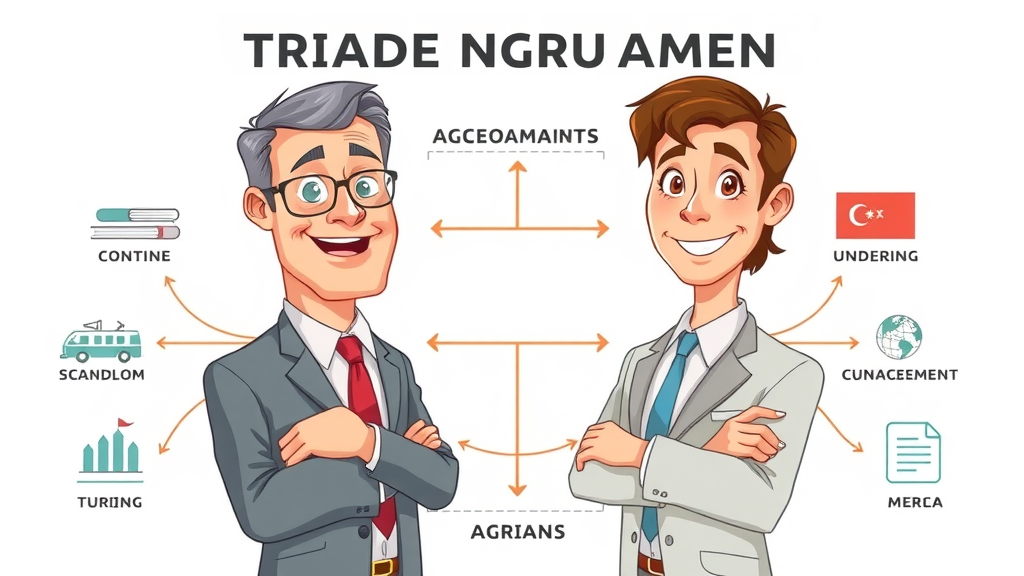Did you know over 60% of global business relies on some form of trade agreement—yet countless manufacturers leave valuable opportunities on the table? This truth may surprise you, but understanding and strategically leveraging free trade agreements and other trade agreements can shift the competitive landscape for those who manufacture goods and services. If you’re ready to discover actionable strategies and unexpected insights—from the landmark policies of the United States and European Union to overlooked steps for business growth—this article will empower you to maximize benefits from every trade agreement available.
Unlocking the Power of Trade Agreements: A Surprising Perspective
For manufacturers, trade agreements are both opportunity and challenge. Many companies believe that tariff cuts and market access happen automatically once a free trade agreement or multilateral pact goes into effect. But in reality, maximizing benefits from every trade agreement requires proactive engagement, regulatory awareness, and sometimes bold innovation. The goal of this article is to provide manufacturers and trade policy stakeholders with in-depth, yet accessible, insights they need to unlock the power of these agreements. We’ll explore their influence on market entry, supply chains, compliance, and competitiveness by drawing lessons from the world’s most influential actors: the United States and the European Union.
- How trade agreements impact manufacturers
- Insights on optimizing free trade and trade agreements
- Examples of influential trade agreements
- Actionable strategies for stakeholders
- The role of the United States and European Union

The Real Value of Trade Agreements for Manufacturers
"Did you know that over 60% of global trade flows occur under some form of trade agreement? Yet, many manufacturers tap into only a fraction of the benefits available."
Trade agreements, be they bilateral, multilateral, or focusing on free trade, are the backbone of modern manufacturing success. Amidst growing global competition and shifting regulations on goods and services, manufacturers who regularly review and understand key trade agreements are positioned to thrive. Free trade agreements, in particular, help reduce tariffs, improve investment relations, and enhance the flow of critical minerals and other strategic resources. However, only manufacturers who invest the time to interpret these agreements and adapt their business models reap the true rewards of free trade in critical sectors. Missing out means risking higher costs, limited market access, and an erosion of competitive advantage—even as significant benefits go untapped.
The United States and the European Union have long championed comprehensive free trade agreements, and their approach to trade and investment relationship building sets a precedent for others. These trade agreements frequently address trade in critical areas, set frameworks for supply chain cooperation, and establish standards for compliance. The most successful manufacturers are those that don’t just wait for benefits to trickle down—they seek details on official websites, invest in compliance education, and actively monitor gov websites use https for information only on official framework agreement updates. This proactive stance ensures that both large companies and SMEs can enjoy more predictable investment relations and seize educational opportunities for continuous improvement.
Understanding Trade Agreement Fundamentals
- Definition of trade agreement: A contractual pact between two or more trading partners, which outlines rules, tariffs, and standards for cross-border trade in goods and services.
- Types of trade agreements: Free trade agreements (FTAs), bilateral agreements, multilateral agreements, and framework agreements focused on different sectors.
- Role in global commerce: Trade agreements create an environment for smoother trade, attract foreign investment, support export growth, and foster a competitive marketplace for partner countries.

Making Trade Agreements Work: Lessons from the United States & European Union
Looking to the United States and European Union provides a clear roadmap for extracting the most value from any trade agreement. The US excels at negotiating comprehensive free trade agreements covering investment relationship issues, critical minerals, and evolving market standards. The European Union, meanwhile, masters unified standards and sophisticated policy harmonization, which streamlines trade in goods and services across many countries. What both have in common is a dedication to stakeholder engagement, continuous policy review, and transparent gov website publication of agreement details—all of which contribute to long-term manufacturing advantage. By studying their approaches, companies anywhere can adapt best practices for maximizing the benefits of free trade agreements and other frameworks, regardless of complexity or trading partner.
Successful manufacturing firms in these jurisdictions regularly consult official websites and stay alert to ongoing policy updates in free trade agreements. These lessons prove especially valuable for those seeking new trading partners or considering investment relations in untapped regions. For example, both the United States and the European Union spearheaded agreements focusing on free trade in critical sectors, with transparent rules and pathways for expansion. This adaptability and clear focus on standards keep both manufacturers and economies resilient as global trade evolves.
As you refine your approach to leveraging trade agreements, it’s also essential to streamline related processes such as customs clearance. For practical tips that can help you avoid common bottlenecks and accelerate your cross-border operations, explore these proven customs clearance hacks that simplify compliance and documentation: simplify your customs clearance process with these hacks.
Best Practices: Free Trade Agreements in Action
| Trade Agreement | Participating Parties | Key Benefits |
|---|---|---|
| USMCA | United States, Mexico, Canada | Reduced tariffs, Improved IP protection |
| EU-Japan EPA | European Union, Japan | Increased market access |
| African Continental FTA | African Union members | Economic integration |
"When leveraged strategically, free trade agreements can boost manufacturing exports by up to 30%."

People Also Ask About Trade Agreements
What is a trade agreement?
A trade agreement is a contractual arrangement between states or entities that outlines rules and standards governing trade in goods and services between the parties.
What is an example of a trade agreement?
An example is the North American Free Trade Agreement (NAFTA), now the United States-Mexico-Canada Agreement (USMCA).

What is the purpose of these trade agreements?
The purpose of trade agreements is to reduce barriers and promote economic cooperation by establishing clear trade rules.
What are the three types of trade agreements?
The three types are bilateral, multilateral, and unilateral agreements.
Strategies for Maximizing Gains from Trade Agreements
Whether your company is multinational or an SME seeking growth, consistent attention to emerging trade agreement frameworks is key. Here are practical strategies for ensuring you not only comply with but benefit from the terms negotiated in free trade agreements, bilateral deals, or comprehensive multilateral arrangements. Every step requires collaboration among industry, government, and partner countries, making official websites and gov websites use https best practices for tracking updates and sensitive information.
- Conduct regular trade policy reviews
- Encourage industry-government collaboration
- Invest in compliance and standards education
- Monitor updates to agreements
- Engage in stakeholder consultations

FAQs on Trade Agreements for Manufacturers
-
How do changes in free trade agreements affect supply chains?
Changes in free trade agreements can disrupt or enhance supply chains by altering tariffs, modifying import/export requirements, and introducing new compliance standards. Manufacturers must be agile and regularly review agreement terms via official websites to proactively manage supply chain risks and opportunities. -
Should SMEs consider entering new markets under new trade agreements?
Absolutely. New trade agreements often open doors to fresh markets with reduced trade barriers. SMEs can access updated resources on gov websites and official websites to ensure their entry aligns with regulatory expectations and market demand, unlocking new streams of revenue. -
What are the common pitfalls in utilizing trade agreement benefits?
Common pitfalls include misunderstanding rules of origin, missing updates, neglecting compliance training, and relying solely on outdated information. Engaging in stakeholder consultations and referencing government websites ensures manufacturers don’t miss critical details. -
Where can manufacturers find official agreement texts and implementation guides?
Manufacturers should visit official government websites or international organization platforms. Websites use https for secure access to sensitive information. These resources provide comprehensive information, including implementation guidelines for all significant free trade agreements and multilateral frameworks.
Key Takeaways: Navigating the Future of Trade Agreements
- Trade agreements unlock broad manufacturing benefits if approached strategically
- Both the United States and European Union set influential precedents
- Continuous adaptation and education are critical
- Leveraging free trade agreements can spark exponential growth

Conclusion: Free Trade and Trade Agreements as Catalysts for Manufacturing Growth
"The future belongs to manufacturers who see beyond tariffs and paperwork and champion proactive engagement with every trade agreement available."
If you’re eager to take your understanding of trade agreements to the next level, consider exploring advanced international trade strategies that drive sustainable growth. Delving into these broader approaches can help you identify new opportunities, anticipate market shifts, and build a resilient business model in the face of global change. For a deeper dive into actionable frameworks and expert insights, discover how to unlock growth with international trade strategies at this comprehensive guide.
Got Something to Say About Global Trade?
RP Design Web Services can put your insights on Global Trade Notes in front of the right audience. Call 203-271-7991 today and get your word out.
To deepen your understanding of trade agreements and their strategic benefits, consider exploring the following resources:
-
“Free Trade Agreement (FTA): Definition, How It Works, and Example”: This article provides a comprehensive overview of free trade agreements, explaining their mechanisms and offering practical examples to illustrate their impact on international trade. (investopedia.com)
-
“Trade Agreements | United States Trade Representative”: This official resource outlines the various trade agreements the United States is involved in, detailing their scope and the benefits they offer to businesses and the economy. (ustr.gov)
By delving into these materials, you’ll gain valuable insights into how trade agreements function and how to leverage them effectively for business growth.
 Add Row
Add Row  Add
Add 




Write A Comment